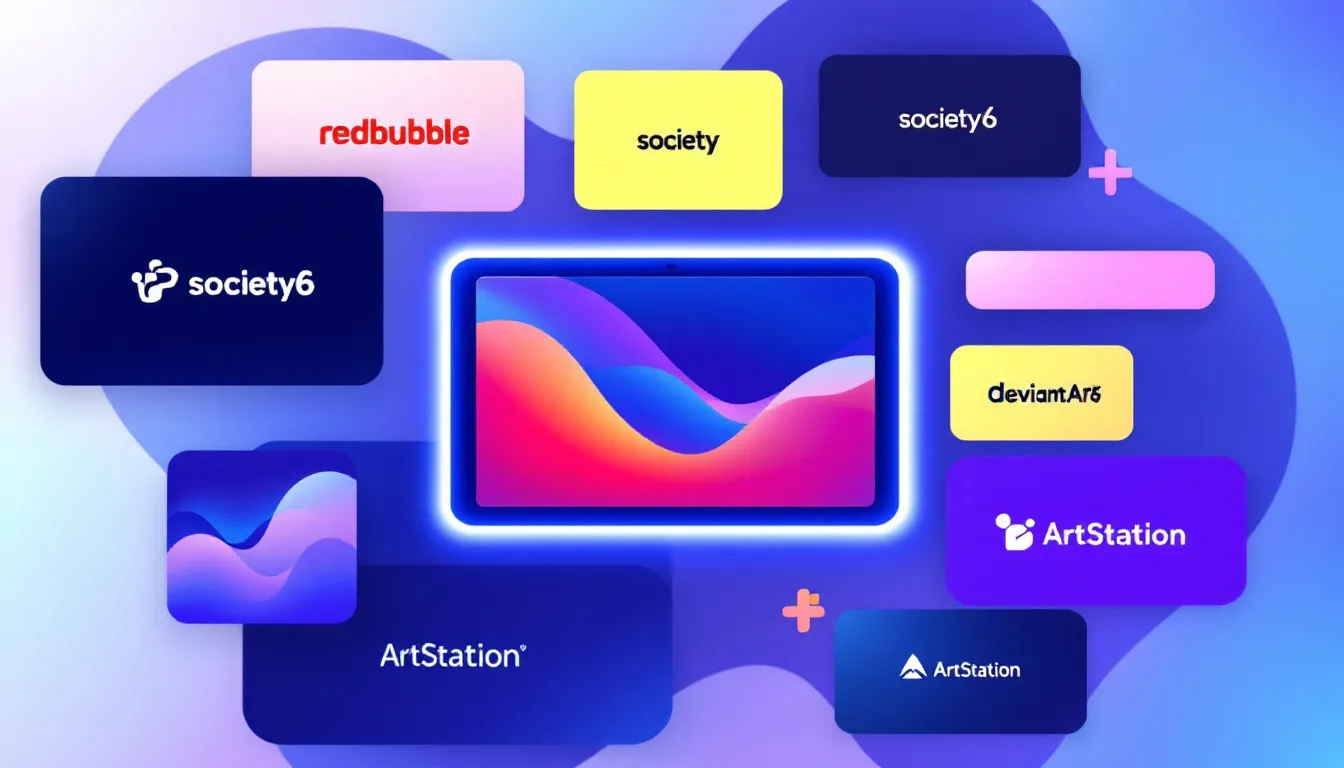Want to sell digital art and make money online? This article will guide you through essential steps like selecting the best platforms, setting prices, and using effective marketing tactics. You’ll learn practical tips to turn your digital art into a profitable business.
Key Takeaways
-
Digital art offers diverse products and formats such as NFTs, downloadable wallpapers, and custom commissions, enabling creators to express their unique talents.
-
Selling digital art online is a lucrative opportunity with significant market demand; artists can boost profitability by focusing on niche audiences and employing effective marketing strategies.
-
Establishing a strong online presence through the right platforms and protecting your work with licensing and watermarks are key steps for building a successful digital art business.
Understanding Digital Art

Digital art encompasses a wide range of creations, all made or enhanced using digital tools. From illustrations and 3D models to animations and photo manipulations, the possibilities are endless. In the digital art world, you’ll find various forms such as digital artwork, digital paintings, pixel art, and interactive media, each offering unique ways to express creativity.
Creating digital art involves different mediums and formats. Digital drawings, concept art, and graphic designs are just a few examples under the digital art umbrella.
Digital art products come in various popular forms. Examples include:
-
wallpapers
-
stock images
-
coloring pages
-
editable images
-
digital cards
-
fonts
-
site templates
-
fan art
-
custom commissions
-
NFTs
Each of these forms provides a unique opportunity for artists to showcase their talents and reach diverse audiences.
The beauty of digital art lies in its versatility and the ability to experiment with various art forms. Whether you are a seasoned digital artist or just starting, understanding the vast landscape of digital art will help you identify your niche and create products that resonate with art enthusiasts and fellow artists alike.
Profitability of Selling Digital Art Online

Selling digital art online is not just a trend; it’s a highly profitable venture. In 2023, online art sales reached nearly $12 billion, showcasing the significant demand and profitability in this market. Digital products now make up a substantial portion of the global eCommerce market, with projections indicating the digital product marketplace will reach approximately $950 billion, much of which comes from digital art.
One of the keys to success in selling digital art is identifying a target niche. Focusing on a specific audience allows artists to create unique and appealing digital artworks that stand out in the competitive market. Successful digital creators often see a growth rate of over 100% year over year, with top sellers generating significant monthly revenue by effectively engaging their customers.
Marketing strategies like order bumps and upsells can increase average order value by up to 129%, and subscription models provide ongoing revenue streams. Choosing the right niche, leveraging effective marketing, and reaching a global audience enables digital artists to build a lucrative business and enjoy the financial rewards of their creativity.
Turning Digital Files into Profitable Products
Turning your digital files into profitable products is the cornerstone of a successful digital art business. The easiest and most accessible way to start selling digital art is by selling digital downloads. This model allows artists to reach a wide audience with minimal upfront costs and no need for physical inventory.
Creating unique digital art products that stand out in the market is crucial for building a following. From AI-generated art to non-fungible tokens (NFTs), the range of products you can offer is vast and ever-expanding. Focus on making products that you love and that help your customers, as this balance of creativity and practicality will set you apart.
Once you’ve created your digital artworks, pricing and publishing them on your chosen platforms is the next step. Building an online art store and promoting your products effectively are essential for driving sales. Whether you’re selling digital downloads or physical products through print-on-demand services, the goal is to turn your digital creations into a thriving business.
Selling Digital Downloads
Selling digital downloads is a popular and effective way to monetize your digital art. Platforms like Etsy and DesignCuts offer excellent marketplaces for artists to sell digital art online, including printables, wallpapers, and design templates. One of the major advantages of selling digital downloads is the ease of transaction and the ability to reach a global audience without the hassle of physical shipping.
Using reliable payment gateways and requiring upfront payment ensures secure transactions. However, one of the risks associated with selling digital files is the potential for unauthorized resale by third parties. Artists must be vigilant and take steps to protect their work from being misused.
Despite the risks, the demand for digital downloads continues to grow, making it a lucrative option for digital artists. Offering high-quality and unique digital download products helps attract a loyal customer base and generate a steady stream of income from your art.
Selling Physical Products through Print on Demand Services
Print on demand (POD) services provide an excellent opportunity for artists to sell physical products without the need to manage inventory or handle shipping logistics. Platforms like Redbubble, Society6, and Fine Art America allow artists to upload their designs and offer a wide range of products, from t-shirts and posters to mugs and tech accessories.
Using print-on-demand services saves time and can generate passive income, as the platform handles manufacturing and shipping. For example, ArtPal’s print-on-demand service lets artists keep all their profits without any commission, making it an attractive option for maximizing earnings.
Artists can easily set up their products on platforms like Printify, which allows for high-quality printing on various items without any upfront investment. Leveraging these services expands your product offerings, including digital prints, and reaches a broader audience, all while allowing you to focus more on creating art.
Choosing the Right Platform to Sell Digital Art

Choosing the right platform to sell your digital art is crucial for reaching the right audience and maximizing sales. When selecting a platform, consider your art style and business goals, as different platforms cater to various audiences. Evaluating the End User License Agreement, terms of use, and market focus of each marketplace is essential to ensure it aligns with your objectives.
Online marketplaces offer significant advantages, including built-in audience access, reduced business setup stress, and potential for viral exposure. Popular platforms like Redbubble, Artnet, Shopify, Etsy, and Creative Market provide diverse options for artists to sell their digital art. Alternatively, creating a personal website using platforms like Shopify gives artists more control over their sales and branding.
Utilizing a reliable payment gateway is also crucial for safely processing transactions when selling digital art. Regular uploads, social media promotion, and newsletters are important for maintaining focus and driving sales on multiple platforms. Finding the right platform is a strategic step in showcasing your digital art and connecting with buyers effectively.
Popular Marketplaces
Mainstream online marketplaces offer a broad audience and established infrastructure to sell art and selling digital art. Fine Art America is a popular platform for selling original art, prints, and home decor, while Saatchi Art allows artists to sell both digital and original artworks to a global audience. These platforms provide extensive reach and can significantly boost an artist’s visibility.
Creative Market is another excellent option, offering a global marketplace for selling original art on various products. ArtStation, known for its focus on digital art, allows artists to earn up to 85% from their sales, making it a lucrative choice for showcasing digital creations. Etsy, with its low listing fees and broad audience, remains a leading marketplace for digital artists.
Each platform has its fee structure, with Etsy charging a $0.20 listing fee and a 6.5% transaction fee. Society6 pays artists 10-30% of the sale price, while platforms like INPRNT and YouWorkForThem offer artists 50% of each sale without any fees. Choosing the right marketplace depends on your goals and the type of audience you wish to reach.
Niche Marketplaces
For artists looking to connect with specific communities, niche marketplaces offer unique opportunities. Platforms like DeviantArt, Behance, and Dribbble host active digital art communities where artists can showcase their work and engage with like-minded creators. These platforms are excellent for building a dedicated following and receiving feedback from fellow artists.
ArtPal’s print-on-demand service allows artists to set their own profits and keep 100% of those profits, providing a flexible and rewarding option for selling digital art. Uploading images to apps like Printful via Shopify can streamline the process of selling digital art through print-on-demand services.
Collaborating with other artists and engaging in joint projects or exhibitions can expand your reach and introduce your art to new audiences. Niche marketplaces cater to specific types of digital art or audiences, making them ideal for artists with specialized styles or themes.
Personal Website
Having a personal website offers unparalleled control over your digital art business. A personal website simplifies payment processing and allows for extensive customization, helping you create a unique brand identity. Shoppers generally have a higher level of trust in artists who have their own professional websites, which can lead to increased sales and customer loyalty.
Platforms like Wix and Squarespace provide user-friendly tools for creating and managing your website. Wix offers a drag-and-drop design tool that makes building a site straightforward, while Squarespace provides integrated e-commerce and marketing tools tailored specifically for selling digital art.
After experimenting with online marketplaces, establishing your own website is a recommended next step to take full control of your business and build a direct relationship with your audience.
Marketing Strategies for Selling Digital Art

Effective marketing is essential for a successful digital art business.
Current trends in digital art emphasize:
-
Vibrant colors and emotional connections, moving away from minimalism
-
Nature-inspired designs
-
Handcrafted elements, making digital art feel more authentic and personal.
Building a solid brand identity is crucial for standing out in the competitive digital art market. Understanding market trends and refining marketing strategies are key to connecting with potential customers and driving sales. Social media platforms like Facebook have proven to yield a high rate of return for digital artists, making them essential tools for customer acquisition.
Focusing marketing efforts on a defined niche makes it easier to connect with loyal customers and enhance conversion rates. Monitoring where potential customers spend their time online can significantly improve your marketing strategies and help you reach your target audience effectively.
Social Media Marketing
Social media platforms like Instagram, YouTube, and TikTok are excellent for promoting digital art and reaching potential customers. These platforms allow artists to share their work in various formats, engage with followers, and build a supportive community around their art.
When showcasing your work on social media, it’s important to share your artistic journey rather than simply pushing for sales. Adding phrases like ‘Commissions available’ in your bio with a link to your storefront can effectively promote your services. Platforms like DeviantArt and Dribbble also serve as active communities for digital artists to showcase their work and connect with fellow creators.
Using social media to share behind-the-scenes content, process videos, and personal stories can help you engage with your audience and attract potential customers. Effectively leveraging these platforms helps build a loyal following and drives traffic to your online store.
Email Marketing
Email marketing is a powerful tool for digital artists to engage with potential customers and drive traffic to their online platforms. Building an email list allows artists to send personalized updates about new artworks, exclusive offers, and behind-the-scenes content, creating a deeper connection with their audience.
Segmenting your email list allows you to tailor content to specific groups, enhancing engagement and relevance. By sending out regular newsletters and promotional emails, you can keep your audience informed and excited about your latest creations.
Effective email marketing can significantly boost your online presence and sales.
Collaborations and Partnerships
Collaborating with other artists can lead to unique projects that attract wider audiences and boost sales. Partnering with fellow artists allows for sharing skills, resources, and exposure to each other’s followers, multiplying potential reach. Engaging in joint projects or exhibitions can also introduce your art to new audiences and create exciting opportunities for creative growth.
Influencers can effectively promote digital art through their platforms, expanding the visibility of your work. Collaborating with brands can create new revenue streams and improve brand visibility, making it a valuable strategy for building a thriving digital art business.
Protecting Your Digital Art

Protecting your digital art from unauthorized use is crucial for maintaining ownership and control over your creations. Digital art often ends up on torrent sites, leading to widespread unauthorized use. Implementing measures like watermarks, low-resolution previews, copyright registration, and licensing can help safeguard your work.
Adding watermarks to your images not only deters theft but also strengthens claims of ownership. Low-resolution previews allow artists to share their work and attract potential buyers without exposing the full-quality image to theft. Digital watermarking also serves as a deterrent against unauthorized use of images.
Copyright registration helps establish legal ownership and provides a public record of creation. Using digital rights management (DRM) tools can further protect your digital artworks from being misused. Taking these steps ensures that your art remains protected and that you maintain control over its use.
Watermarking and Low-Resolution Previews
Visible watermarks act as a strong deterrent against unauthorized use of digital art while providing a clear indication of ownership. Adding watermarks to your images can prevent theft and unauthorized reproduction. Platforms like Dropbox allow you to add watermarks to PDFs, offering an additional layer of protection.
Disabling full-resolution sharing and using low-resolution previews can minimize risks while showcasing your work. These previews allow you to share your art with potential buyers without exposing the high-quality images to theft.
By implementing these measures, you can protect your digital art and maintain control over its distribution.
Legal Considerations and Licensing
A commercial license defines legal usage and protects reproduction and resale rights. Creating a commercial license can be done by drafting your own terms of use or using marketplace-specific tools. This legal protection ensures that your digital art is used appropriately and that you retain control over its distribution.
Customers often breach licensing agreements unintentionally, creating more work for artists. Clear communication and well-defined terms can help prevent these issues and ensure that your art is used in accordance with your guidelines.
Understanding the legal aspects of selling digital art helps protect your work and maintain control over its use.
Setting Prices for Digital Art
Setting the right price for your digital art is crucial for maintaining profitability and perception within the industry. The time and effort invested in creating digital artworks should be significant factors in determining their prices. Conducting market research helps artists identify standard pricing for similar digital items, which can inform their pricing strategy.
Underpricing digital art can be damaging to an artist’s long-term business and influence how the industry perceives their work. Artists can adopt multiple pricing tiers to cater to various collector preferences, enhancing their sales potential.
An artist’s reputation and past success can also justify higher prices compared to less established creators. Carefully considering these factors and implementing effective pricing strategies ensures that your digital art is valued appropriately and helps you achieve financial success in the digital art market.
Building a Thriving Digital Art Business
Building a thriving digital art business involves multiple sources of income and effective marketing strategies. Print on Demand services can expand your revenue streams and reach a broader audience. Developing an email list allows artists to send personalized updates about new artworks and exclusive offers, creating a deeper connection with their audience.
Email segmentation helps tailor content to specific groups, enhancing engagement and relevance. Sending welcome emails sets a positive tone for new subscribers and outlines what kind of content they can expect.
Implementing these strategies helps build a sustainable and profitable digital art business.
Time Management and Productivity
Effective time management techniques are crucial for digital artists to enhance their productivity. Utilizing time-blocking techniques can assist in allocating specific periods for focused work, enhancing productivity. Setting clear daily and weekly goals can help artists stay organized and prioritize their workload effectively.
Using accountability methods, such as planning work for the next day, can help maintain focus and prevent burnout. Implementing these time management strategies ensures that you make the most of your creative time and achieve your business goals.
Continuous Learning and Improvement
Ongoing education and skill enhancement are vital for digital artists to adapt to market changes and remain competitive. Engaging in online courses and workshops can significantly enhance your skills and keep you abreast of industry trends.
Participating in art challenges and critiques can provide valuable feedback and spur artistic growth. Embracing trial and error as a way to discover effective strategies for growth and development can help you continuously improve and succeed in the digital art market.
Summary
Selling digital art online in 2025 offers immense potential for artists to turn their creativity into a thriving business. From understanding the various forms of digital art to choosing the right platforms and implementing effective marketing strategies, there are numerous ways to succeed in this dynamic market. Protecting your digital art, setting the right prices, and continuously improving your skills are all essential components of building a successful digital art business.
As you embark on your journey to sell digital art online, remember that persistence and creativity are key. By leveraging the insights and strategies shared in this guide, you can navigate the digital art world with confidence and achieve your artistic and financial goals. The digital art market is waiting for your unique creations—take the first step and start selling your digital art today!
Frequently Asked Questions
What are the most popular platforms for selling digital art online?
Selling digital art online is best done through popular platforms like Fine Art America, Saatchi Art, Creative Market, ArtStation, and Etsy, as they cater to diverse audiences and provide great opportunities for exposure. Embrace these platforms and watch your art reach new heights!
How can I protect my digital art from being stolen or misused?
Protecting your digital art is essential, and using watermarks, low-resolution previews, copyright registration, and digital rights management (DRM) tools can effectively safeguard your creations. By taking these steps, you can maintain control over how your art is used and shared.
What factors should I consider when setting prices for my digital art?
To effectively price your digital art, focus on the time and effort you’ve invested, conduct thorough market research, consider your reputation, and offer various pricing tiers to appeal to different collectors. Embracing these factors will help you find the right balance and attract potential buyers!
How can I effectively market my digital art online?
To effectively market your digital art online, leverage social media, email marketing, and collaborate with fellow artists and influencers for greater visibility and engagement. It’s exciting to see your art reach more people!
What are the benefits of having a personal website for selling digital art?
Having a personal website for selling digital art is incredibly beneficial as it gives you full control over your branding and sales process, while also simplifying payment processing and building customer trust. This empowered approach can significantly enhance your art business!

